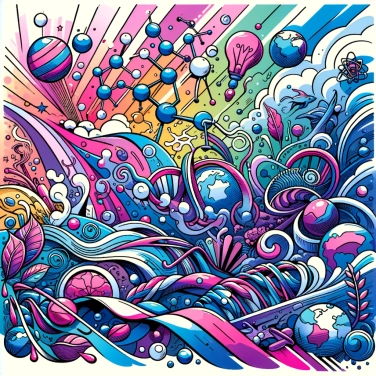The color of the sky changes at sunrise and sunset due to the scattering of sunlight by atmospheric particles. When the sun is low on the horizon, light must pass through a greater thickness of atmosphere, which promotes the scattering of shorter wavelengths (blues) and creates characteristic orange and red hues.

The color of the sky mainly varies due to a phenomenon called Rayleigh scattering. It’s a simple physical effect: when sunlight enters the atmosphere, it encounters air molecules that scatter the light in all directions. However, not all colors are equal when it comes to this scattering. The shorter wavelengths — like blue and violet — are scattered much more efficiently than longer colors such as red or orange. The logical result: during the day, your eyes primarily capture this highly scattered light, hence the typically blue sky. As for violet, even though it is scattered even more intensely than blue, our eyes are much less sensitive to it, making it almost invisible to us.
The distance that sunlight travels through the atmosphere changes significantly depending on the time of day. At noon, the sun is directly overhead, so the light passes through a thin layer of atmosphere and the sky mostly appears blue. However, at dawn or dusk, sunlight travels through a much thicker layer of air. During this prolonged journey, a large part of the colors with shorter wavelengths (like blue or green) is scattered and dispersed away from our eyes. As a result, mostly the colors with longer wavelengths, such as red, orange, and yellow, remain. That's why these moments offer us such spectacular warm hues!
The color you see mainly depends on the wavelength of light. Blue, for example, has a shorter wavelength, which means it scatters easily in all directions. During the day, this dominant scattered blue easily reaches your eye, which is why the sky appears mostly blue. At sunrise and sunset, it’s a bit different: since the light has to pass through a large thickness of the atmosphere, the short wavelengths are scattered so much that they hardly reach your eye anymore. Longer wavelengths, like red or orange, manage to travel that distance more easily, giving the sky its beautiful red and orange hues at twilight. Your eye, by the way, particularly captures these warm colors under these specific atmospheric conditions.
Particles present in the air, such as dust, pollution, or even smoke, directly influence the colors of the sky. When they float gently in the atmosphere, they act a bit like tiny scattering mirrors. As a result, the colors at sunset or sunrise become more intense. If there is a lot of pollution or industrial dust floating in the air, the sky often turns to more pronounced shades of red, orange, or even pink. It's pretty, but it also shows that the air is loaded, so not very clear. Conversely, in truly clean air, like after a good rain, the hues will be softer and lighter, with less dramatic intensity.
Clouds can act as an artist's canvas during sunrise or sunset: their altitude, thickness, and composition greatly influence the observed colors, thus providing a different spectacle for the eyes each day.
The phenomenon responsible for the beautiful pink and orange hues during sunrises and sunsets is scientifically known as 'Rayleigh scattering', discovered by Lord Rayleigh in 1871.
The blue color of the sky during the day is due to the selective scattering of short-wavelength colors, such as blue and violet. However, since the human eye is less sensitive to violet, we predominantly perceive blue.
On Mars, the sunset appears bluish due to the thick dust present in the Martian atmosphere, which primarily scatters colors close to red, allowing blue to filter through to the human eye.
Clouds appear pink or purple when the sun is below the horizon because they reflect sunlight that is scattered by the atmosphere. The pink or purple hues come from the enhanced scattering of other intermediate colors like violet, combined with their original shade.
Yes, particularly in desert regions or near oceans, as clean air or air slightly charged with dust and sea salt produces more intense sunsets. However, heavily polluted areas can also create spectacular colors, even though they indicate poor air quality.
The most vivid colors appear about 20 to 30 minutes before or after sunrise or sunset. It is during these times that the atmosphere, in its particular configuration, diffuses warm colors with the greatest intensity.
Yes, air pollution, such as particles from industries and road traffic, can influence the observed colors. These additional particles sometimes enhance orange and red tones, resulting in particularly colorful sunsets, but they also indicate degraded air quality.
The sky appears blue during the day due to a phenomenon called Rayleigh scattering. This scattering favors shorter wavelengths like blue, which are scattered in all directions by the gas molecules in the atmosphere, while longer wavelengths like red pass through almost undisturbed.

No one has answered this quiz yet, be the first!' :-)
Question 1/5